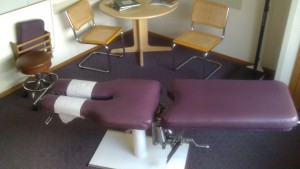What to expect at your first chiropractic visit
Your first visit will take about one hour. I’ll ask you to give me your insurance and identifying information, to read and sign our office policies so everything is clear up front, to agree to binding arbitration, and to fill out a comprehensive health questionnaire. Sounds far more daunting than it actually is- I’ve streamlined everything down to four short pages of essentials.
Next you will have a consultation with me. We’ll discuss your current and past health issues in detail. I will ask a number of clarifying questions so I have a complete picture of your health history. You will be able to ask whatever questions you have.

Consultation and Examination area
When the consultation is complete and your questions are answered to your satisfaction, we’ll move on to the examination. I’ll probe for inflammation and muscle tension. I’ll evaluate your range of motion. I’ll select a suite of orthopedic, neurological, kinesiological and chiropractic examinations to clarify just what is going on in your body.
X-rays are usually not necessary, but if something comes up on the examination that requires further investigation or x-rays before we can proceed, I’ll let you know and we’ll make arrangements to do what’s required.
At this point I’ll know whether chiropractic care is right for you. If so, we’ll move right into your first adjustment. I will realign your entire body from bottom to top, with special attention to the currently painful areas. I don’t work on the problem areas in isolation, because the body is a connected system, and ‘under the radar’ problems in distant areas can complicate your recovery if not resolved.
I use a marvelous diagnostic technique called Applied Kinesiology to evaluate as I go along. Muscle testing reveals problem areas. It’s a way of using the muscles to read out the condition of the nervous system and spinal structures, like your auto mechanic plugging into your car’s internal wiring to make a diagnosis. I check, treat, and recheck as I work.
My most sensitive diagnostic tools, however, are my hands. I’m able to ‘see’ deep into your body, right down to the bones and joints, evaluating in 3-D the motion of each individual joint or the tightness of each individual muscle fiber.
I may use any of a number of advanced adjusting techniques, or a combination of those techniques, to remove the interference I find in your nervous system. I select from my extensive ‘toolkit’ what’s best for your body and condition at the present time. That selection is based on my graduate and postgraduate education, more than three decades of experience in the field, and highly developed intuition. For much more information about the way I work, follow the Chiropractic Techniques link.
Does chiropractic adjusting make noise?
Chiropractic adjustments are frequently accompanied by a ‘pop’. Each joint along the spine contains a fluid, in which nitrogen gas is dissolved. As I adjust the spine by hand, pressure on the stuck joint is relieved, pressure in the fluid drops, the nitrogen comes out of solution to form a bubble, and the bubble pops.

Flexion Distraction Table
The sound is simply a side effect of taking pressure off of a stuck joint. It is not damaging in any way- just the opposite.
If you really just can’t stand the sound, I have alternate techniques that can be used.
Does It Hurt?
When you relax and allow the adjustment, there is very little discomfort. Of course, we must work on already painful and inflamed joints, so a bit of soreness is to be expected. My techniques keep this to an absolute minimum.
How will I feel after my adjustment?
Many patients feel immediate relief, even if the problem has been severe and long standing. There is often a feeling of blood circulating and nerves ‘waking up’ in ways they hadn’t before. Relaxation is common, even to the extent of wanting to nap. Some soreness in the most troublesome areas is likely to remain.
Can I go right back to what I was doing?
Please don’t. See the Taking Care of Yourself page for instructions on how to help your adjustment settle in properly.


